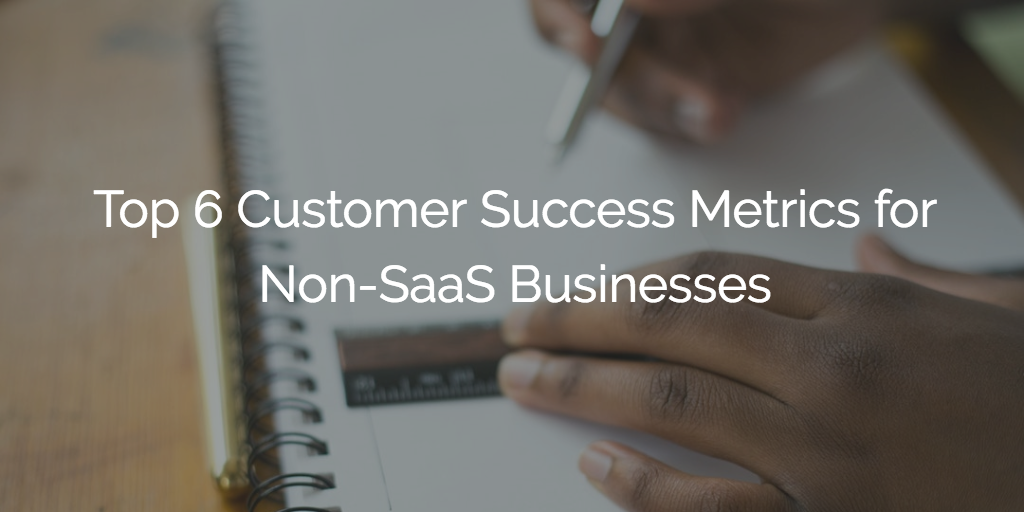The secret is out. Our cover has been blown. Customer Success isn’t just for the SaaS industry.

But really though, it is beyond awesome that businesses of all kinds are realizing the benefits of Customer Success. You absolutely don’t need to have a subscription-based service to care about your customers. However, because Customer Success is so deeply rooted in SaaS, it can be hard to determine what metrics matter when you’re not dealing with subscriptions and contracts. Instead of pulling your hair out, give yourself a pat on the back for bearing the Customer Success torch and read on to learn what metrics will help you measure your efforts.
1. Net Promoter Score (NPS)
Customer Success is the product of exceptional customer experience and customer outcomes, and it’s common practice to solicit customer feedback in the form of a Net Promoter Score (NPS) to determine how effective these measures are. Net Promoter Score measures a customer’s willingness to recommend your product/service to a friend or colleague. Survey takers rank their willingness to recommend on a scale of 1-10 and, based on their answers, are then divided into buckets.
Detractor: 0-6
Passive: 7-8
Promoter: 9-10
NPS will be most accurate when used at strategic moments in the customer journey, such as right after they’ve purchased your product or used your service or after they’ve had an interaction with your support team. Once you have collected your Promoters, Passives, and Detractors, use our NPS calculator to get your NPS score.
2. Customer Acquisition Cost (CAC)
Customer Acquisition Cost is pretty self-explanatory—it’s the amount of money it takes to obtain a new customer. To calculate CAC, add together your cost for sales, marketing, and onboarding efforts, and divide the amount by the number of new customers within a certain time interval (i.e. per month, per quarter, per year).
Sales + Marketing + Onboarding / # of New Customers = Customer Acquisition Cost
The less you have to spend on obtaining customers the better, and Customer Success can help lower this metric. By focusing on delivering outcomes and experiences, you can bring in additional revenue from pre-existing customers. For example, you may have customers using an older version of your product. This is the perfect opportunity to reach out and explain the value of upgrading to the most updated version. Happy customers are more likely to expand into your other products offerings and/or become repeat buyers. They’ll also become advocates for your product, spreading the word to their network and creating net new customers in that way.
Customer Success best practices also stress a more targeted selling approach—farming instead of hunting. In recurring revenue businesses, it’s no longer about landing the initial sale and then leaving them high and dry, it’s about finding people who will benefit from your product and cultivating that success. While you may not follow a contract-based model, the idea can still be applied—by honing in on people who are more likely to get value from your product, you’re saving money by not wasting time on those who will not. The goal here is to figure out how you can grow up and out and get that Customer Acquisition Cost down.
3. Retention Rate
Retention should be on your radar even if you don’t rely on recurring revenue. Most clients need to be retained at least a year to make a return on the CAC you invested in them. To get an idea of your retention rate, first establish a period of time (i.e. weeks, months). Then determine how many customers you started that period with (CS), how many customers you acquired (CN), and how many you ended the period with (CN) and put them into this equation from Inc.com:
Retention Rate = ((CE – CN) / CS) X 100
Your retention rate can reveal how your customers perceive the value of your product. How long did they stay customers? How much money did you lose because you failed to retain someone that didn’t earn you money? What about further than that? If you are losing customers before they reach a breakeven point, you should look into how you’re positioning the product during the marketing and sales stages, how seamless or difficult your onboarding experience is, your overall customer experience, and whether you’re delivering on promised outcomes—just to name a few. A Customer Success Management software can help provide more insight into these areas 😉.
4. Cost of Retention
Cost of Retention is used to track the amount of money spent on retaining customers on an annual basis. To get your Cost of Retention, you add up the total cost of your Customer Success team (CS), technology (T), Onboarding team (O), Account Management team (AM), your customer experience program (CX), and customer marketing (CM), and divide it by the number of active customers that have been retained during that year.
(CS + T + O + AM + CX + CM) / AC = Cost of Retention
The ideal Cost of Retention will vary by industry and business but you want this number to decrease over time. Calculate your Cost of Retention using our metrics calculator.
5. Support Metrics
How you handle a customer’s support issue is a critical moment in the customer journey. It’s important to establish an efficient method of resolving and escalating support tickets and track activity and trends. This will give you insight into the customers’ experience and make it easier to proactively prevent crises. Keep an eye on things like your team’s response time, resolution time, backlog volume, and Customer Satisfaction (CSAT).
6. CSM Efficiency
How much time are your CSMs spending on each customer? How long does it take for them to prepare for customer meetings? The answers to these questions will it give you benchmarks to improve upon, it’ll give you insights into areas of weaknesses that can be solved by updated processes or technology. Having your CS team perform their activities within a dedicated Customer Success Management software can make tracking these metrics infinitely easier.
Are you a non-SaaS business using Customer Success to drive value for your customers? What metrics are you focusing on? Let us know in the comments.

